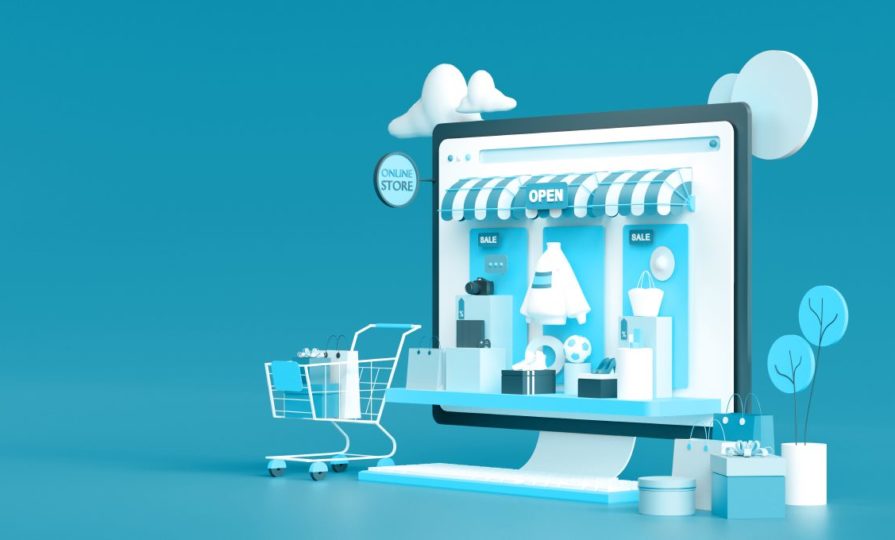To attract and delight customers online, you have to offer immersive experiences
On behalf of Click Consult

By 2021, 82% of the UK population had purchased at least one product online.
The digital age may be approaching a tipping point, but is it already here? Is traditional marketing set to reign supreme once more? In an era where most of the global population uses the internet, standing out from your competition has never been more important.
It’s not enough to be good, you have to be the best!
The task of attracting a customer is no longer as simple as it once was, and it’s even more challenging when you have a short timeframe to do so. A slow website or app will likely lose a good few customers… who won’t return if the website isn’t up to the job.
“Nearly 60 percent of consumers will abandon a site if they experience more than three seconds of load time” (source)
Can you afford to be operating in ‘the norm’?
In real life and augmented reality
“While Gen Z does tend to spend more time than other generations online, they are also the most adverse to digital ads of any other generation.” (source)
Have we become numb to digital advertising in the modern age? Similar to ‘ad blindness’, this numbness could cause visitors to ignore banner-like information – whether consciously or not.
It’s hard to argue with the fact that digital technologies (and their ecosystems) have dominated budget growth within marketing for over a decade. However, while traditional advertising has seemingly lost some appeal over this time (during which, marketers turned to digital methods like apps and social media), it may again be rearing its head.
Pop-up stores are a terrific chance for businesses, large and small, to generate sales because consumers are increasingly eager to interact with brands through unique experiences.
Pop-up shops, as the name implies, are retail establishments that are open for a brief period of time. While they are mostly physical, there has been an increase in interest in virtual pop-ups as well. Brands may reach a specific audience with both of these strategies and produce an engaging buying experience. An eCommerce store can experiment with IRL shops through physical pop-ups without having to commit to a permanent site.
Pop-up shops are fantastic for firms with a forward-thinking attitude, but they require a lot of imagination and organisation. They aim to increase brand awareness and generate buzz. While this is certainly doable online, you might be wondering – how do I measure the success of my irl pop-up shop?
It is possible by:
- Keeping an eye on footfall
Your content marketing and social media strategy leading up to the major event has been outstanding. Now, it’s crucial not to overlook the chance to gauge its success. Just like tracking visitors to your online store, take the opportunity to identify returning visitors and measure the duration of their engagement with the content they encounter.
- Capturing customer data
With consent, you can transform the process of encountering branded WiFi captive portals, waiver or check-in forms into a pleasant and inviting experience for your guests. It goes beyond a mere checklist item, adding value to their journey before they enter the main experience.
- Importing offline conversions
Enabling the import of data from offline sales or conversions is crucial in constructing a comprehensive overview of your business and the path to purchase. By establishing a connection between offline sales and platforms like Google Ads, you gain valuable insights into the effectiveness of initiatives like pop-up events. This allows you to better assess their impact on your overall marketing strategy.
In order to further enhance customer satisfaction, consider leveraging augmented reality (AR) to create captivating online experiences. This approach allows you to utilise interactive displays, enabling customers to browse products and access digital content. For instance, in the case of your fashion commerce store, you could incorporate digital mirrors that utilize the camera feature on customers’ devices. This way, they can visualise how a particular product would appear on them, adding a unique and engaging element to their shopping experience.
One such brand embracing AR is ASOS. During the Covid-19 lockdowns in-person photoshoots were unfortunately ruled out – so ASOS turned to AR to promote its products to the world. The AR offered realistic and engaging product presentations – and their digital dress-up system “See My Fit” generated fashion content with real-life customers and models without the need to step outside the home.
“See My Fit aims to help customers make more informed purchasing choices, by better showing how products look on models that more closely reflect individual customers. ASOS is the first retailer in Europe to trial the technology.” (source)
The importance of context in content
Content is king. If that’s the case, then surely context is queen.
Fostering a continuous relationship with users involves catering to their specific needs rather than simply pushing content and offers to them. Context is key in creating meaningful content that aligns with the user’s interests and provides information that helps them make informed purchasing decisions or better understand your product.
Content serves as a medium through which customers can experience your product even before making a purchase. In the realm of ecommerce stores, a rich content experience plays a pivotal role due to its immersive capabilities. It allows customers to engage deeply with your offerings, leading to a more impactful and memorable interaction.
Written
The following tips represent just a few of the numerous approaches available to attract and delight your online customers who seek a personalised experience when exploring your fashion commerce site and beyond.
- Customer-centric emails
Understanding your target audience is crucial, and a personalised email can significantly contribute to making customers feel valued and recognized. In the fashion industry, it holds particular importance to craft persuasive copy that specifically caters to a particular demographic. By tailoring your messaging to resonate with their preferences and interests, you can effectively engage your audience and establish a deeper connection with them.
- Optimised product descriptions
To optimise your online presence, it is vital to conduct comprehensive keyword research, with a specific emphasis on long-tail keywords. These keywords are more specific, attracting leads who are actively seeking your products or services. When you identify relevant keywords, strategically incorporate them into your title tags and meta descriptions. However, it is crucial to ensure that the integration is seamless and makes contextual sense, avoiding the temptation to add them indiscriminately. The title tag and meta description are significant because they are the initial pieces of information your audience encounters when discovering a website, establishing relevance and capturing their attention.
- Match the item to the product description
Ensuring consistency and accuracy between the product description and the actual product is crucial to avoid stumbling at this critical stage. Instances where the product description fails to align with the actual product can portray the brand as negligent and indifferent towards its customers. Moreover, the choice of copy displayed on the website significantly impacts the level of satisfaction a customer experiences upon receiving the product. Therefore, it is essential to maintain transparency and deliver on the promises made in the product description, fostering trust and enhancing customer satisfaction.
Imagery
Product photos play a pivotal role in driving online sales, as 93% of consumers prioritize visual appearance when making purchasing decisions. The power of imagery in conveying a compelling story cannot be understated, and we understand your desire for a successful and satisfying outcome.
An effective SEO practice to implement is to appropriately name your photo files, incorporating your product name and relevant keywords. Additionally, don’t forget to include a descriptive alt tag for accessibility and improved search engine optimization. By optimising your visual content, you enhance its discoverability and maximize its impact on potential customers.
Vogue states:
“The way products are shot and displayed is an essential purchase driver for brands and marketplaces. Everything from the framing and lighting of a photo to the styling of the product can make or break the customer’s decision to add to cart.”
Social commerce
An additional content avenue is ‘social commerce’. Hootsuite succinctly phrases it as:
“Social commerce is the process of selling products and services directly through social media. With social commerce, the entire shopping experience from product discovery and research to checkout, takes place right on social media.”
Social commerce, although distinct from traditional eCommerce, holds immense potential as the future for brands aiming to differentiate themselves in a crowded marketplace. In essence, social commerce allows customers to make purchases directly within their social media apps or platforms, eliminating the need for redirection to external websites.
This seamless integration enables a convenient and uninterrupted shopping experience, enhancing customer engagement and streamlining the path to purchase. By embracing social commerce, brands can tap into the vast opportunities presented by social media platforms and stay ahead in an ever-evolving digital landscape.
Live selling
Live selling, or live-streaming commerce is the practice of using live video streaming on social apps to sell products directly to consumers. In 2022, live-streaming commerce accounted for $514.20 billion in sales in China, and while it has yet to get to the same level of sales in the West – it will inevitably gain traction among users worldwide.
There are a number of benefits to live selling, such as:
- Offering an immersive experience for your customers
- Allowing customers to make a real-time purchase
- Live shoppers are 40% less likely to return an item than other online shoppers
- There is more scope to better scale your business as you are able to reach a broader audience
“Consumers see brands’ social channels as a personable extension of the brand, so live selling that validates that perception is key” (source)
Active participation of customers during live selling sessions can significantly enhance the overall experience and drive sales. Encouraging customers to actively engage and participate in the live stream creates a sense of involvement and connection. By soliciting their input, answering their questions, and valuing their opinions, you make them feel like valued participants in the conversation. This level of engagement not only increases their interest but also fosters a deeper connection with the brand, ultimately leading to a higher likelihood of making a purchase.
User generated content (UGC)
At its essence, user-generated content (UGC) brings authenticity and credibility to a brand. UGC refers to various forms of content, including images, videos, text, and audio, created and shared by users on online platforms like social media.
Word of mouth remains a powerful channel for any brand, as people inherently trust recommendations from others. Leveraging UGC allows brands to showcase real experiences and opinions of their customers in the digital realm, effectively capturing the essence of word of mouth.
By featuring content generated by those who actually purchase from the brand, UGC becomes a valuable tool for building trust, fostering authenticity, and resonating with potential customers.
User-generated content (UGC) has a remarkable impact on converting customers into making a purchase, as it is found to be five times more effective than professional product shots.
Types of UGC include:
- Vox pops
- Reviews
- Dedicated hashtags
- Tagging
Finally…
In the world of fashion eCommerce, there are numerous strategies to attract and delight your customers, and the ideas presented in this article serve as a valuable starting point. Given the overwhelming and highly competitive nature of the industry, it becomes crucial to differentiate yourself from the crowd in order to achieve success. While the article provides initial insights, it is important to continuously explore and implement innovative approaches that set your brand apart, ensuring a memorable and satisfying experience for your online customers.
By staying ahead of the curve and consistently delivering exceptional value, you can establish a strong position in the fashion eCommerce landscape.









